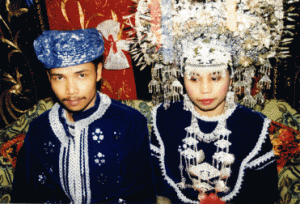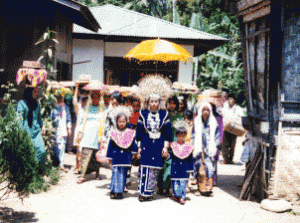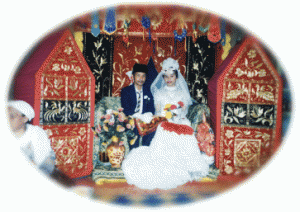Life Among the Minangkabau of Indonesia
Peggy Reeves Sanday
Minangkabau Love and Marriage
The celebration of a marriage breaks the routine of daily life with a crescendo of color, costume, ritual eating, and exchanges involving men and women of many matrilineal clans. The bride and groom occupy center stage for the days of the ceremony during which time they hold court on a wedding couch receiving well-wishers bearing gifts. The couch with its backdrop of colorfully embroidered red and gold brocade is built like a throne in the matrilineal households of both bride and groom. The couple moves back and forth between the households accompanied by a colorful procession of women bearing food offerings for women at the other household.
Arranging the Marriage: delicate steps
Most marriages are arranged by close family members. Clan affiliation is one of the prime factors in choosing a mate with some clans being more preferred than others. Romantic love may or may not play a role. Eggi’s mother, for example, refused to marry her family’s choice, choosing instead to run off with Eggi’s father. In the case of daughters families look for a responsible, hardworking man. For their sons families seek a household that can sustain him and his offspring. The preferred marriage is between a woman and her maternal cousin (her mother’s brother’s son.) Because such a marriage joins two clans with a history of mate exchange and family ties, the arrangement is called “keeping the fish in the pond.”
The wedding depicted in these pictures is typical of today’s marriage arrangements. Edison declared his love to Et by letter asking her to “walk out” with him. Walking out means appearing together on the roads and paths of the villages and taking little trips. Twenty-two at the time and dreaming of going to school in the city, Et had no thoughts of love or marriage with Edison or anyone else. Eventually she agreed and they saw each other for three years before marriage entered the picture.
Marriage proposals are never made outright. Everyone involved proceeds gingerly, testing the waters each step of the way. In this case Edison’s family took the first step by sending one of their inmarrying males to speak to Et’s mother asking if Et was ready to get married. Her mother talked it over with Et’s father and the parents agreed that it was up to Et, which was an indirect way of showing their approval. The next step was to ask Et what she thought. When she said it was up to her parents, this was a sign that she agreed.
Arranging the Wedding: careful negotiatioins
Once all close relatives are informed of the agreement to marry, a meeting is held to arrange the wedding. The negotiation begins with an official exchange between the male leaders of Et’s and Edison’s matrilineal clans as a sign that the two clans are now married. For the duration of the engagement period, Edison’s family gives their ancestral dagger, the premier symbol of male leadership; Et’s family gives gold in return, the symbol of female ancestral wealth. This exchange binds the clans so that neither Et nor Edison can withdraw without great cost to both families.
The negotiations which ensue concern wedding costs, which can be quite substantial. Usually the groom’s family pays for the bedroom furniture, which will be on display during the marriage ceremony in the room they will share at the bride’s house. The families of the fathers of bride and groom rent the wedding clothes. Other considerations concern entertainment costs for the days of the wedding and food arrangements. There must also be an agreement between the two families on the amount to be paid to Edison’s family on the day of the wedding. In anthropological terms this is known as a groom price. The Minangkabau are one of the few examples of societies where the husband’s rather than the wife’s family is compensated. This is understandable given the fact that the Minangkabau husband moves into his wife’s household and provides his labor.
The Wedding Festivities
Wedding ceremonies are somewhat standardized. First comes the Islamic ceremony and then the traditional wedding feast and festivities, which involves most of the village. In preparation for the latter, bride and groom are clothed at the house of their father’s matrilineal relatives, usually the father’s mother and sisters. The festivity starts when bride and groom go to the houses of their father’s matrilineal kin to be dressed. After she is dressed, Et is accompanied by her father’s matrilineal relatives back to her mother’s household. Atop their heads they carry prescribed foods and sweets, some of which will be presented to the members of Et’s household and some will be taken in another procession to the members of Edison’s household. Et’s wedding outfit with its colorful tiara is trademark Minangkabau. Red is the preferred color for bride and groom, but other colors can be substituted.
The bride Et emerges from the matrilineal household of her father where she has been dressed in a rented wedding outfit. Her father’s matrililneal relatives and their spouses accompany her back to her mother’s household. Atop their heads they carry prescribed foods and sweets, some of which will be presented to the members of Et’s household and some will be taken in another procession to the members of Edison’s household.
Upon arrival at her household, Et sits on the wedding couch while the women who have accompanied her eat. Also present at this celebratory meal are many of Et’s friends, from the village and the city where Et worked as a seamstress. At the end of this meal, Et embraced each of them wishing them a tearful farewell. After her friends leave Et prepares to walk in a procession over to Edison’s house to fetch him back to her house.
While Et receives her friends in the front of the house, senior male leaders representing the clans of Et’s father and mother share food in another room. Here they will speak indirectly about the proceedings through a litany of proverbs. These proverbs mark the occasion and communicate common expectations regarding marriage. The men will speak in set proverbs, however I have found that over the years fewer and fewer men actually remember what they are to say. The audience for this ritual interchange is small, just the men who are speaking and a few of their friends.
A new procession forms at Et’s house to accompany her to fetch Edison. The group includes some of the women who came from Et’s father’s matrilineal household along with close family members from Et’s matriclan. The offerings carried by the women are rich with gender meanings associated with the physical and social perpetuation of the generations.
For example, offerings such as a live cock, rice seeds for germination and sprouted coconuts for planting mark the reproductive potential of the couple. References to the groom as the “cock,” symbolizes his role as seminator. The cooked chicken carried by a woman in this group symbolizes the role of women in nurturing and transforming raw energy. The elaborately prepared sweets and cakes the women also bear are symbolic of the Minangkabau love for elaborate, graceful, ritual interaction.
At Edison’s house Et and Edison sit together for the first time since their marriage. They sit on the wedding couch while groups of guests come and go, eating on the floor in front of them. As they leave, the guests speak briefly to the bride and groom and leave a gift beside them. Befitting the demeanor of a bride, Et’s eyes are shuttered. She sits stiffly throughout the ceremony never indicating her emotions. After everyone eats, the men of the two matriclans–Et’s and Edison’s–engage in a ritual exchange of proverbs and the agreed upon price for Edison is ritually presented. The exchange is marked and sealed with more proverbs and the requisite chewing of sirih leaves that finalizes all ritual exchanges.
On the final day of the traditional wedding ceremony, Et and Edison bow to modernity by appearing on the wedding couch in fashionable European wedding clothes. They sit until about midnight and are then escorted by Edison’s friends back to her house. Edison joins his new bride in their newly furbished bedroom, the only part of the house they will share, after eating and talking with his friends late into the night.


